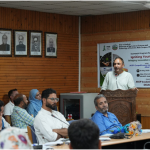Dr. SAURABH GARG
Indispensability of digitalization as a foundational rail to almost every activity in an economy is well acknowledged. Growing internet penetration, affordable data, technological innovations, and above all, the government’s thrust on building digital infrastructure is ensuring faster delivery, better targeting, and improved accountability.
The Digital Impact
During the period 2014-2019, India’s core digital economy increased from 5.4% to 8.5% of GVA. The digital economy grew 2.4 times faster than the overall economy during the same period. The digitally dependent economy accounted for around 22% of the total economy in 2019, as per an RBI bulletin recently published. The government’s emphasis has been on developing Digital Public Infrastructure (DPI) which, ensures public availability of digital components for more participative service delivery systems, triggers market-led innovations, facilitate more affordable & faster on-boarding of services, and ensures development of more transparent systems and thus increased user trust.
The cascading effect of Digital India geared towards improving accessibility, affordability, connectivity, and inclusivity is now visible across India. Aadhaar, a key component of digital infrastructure, through its inherent virtue of uniqueness has become an important tool of digital governance in the country. Nearly 1700 welfare and good-governance schemes of the central and state governments using Aadhaar is a testimony to that. Use of Aadhaar has ensured benefits reaching the intended beneficiaries without leakages. For example in PDS, significant reduction in diversion of grains owing to computerized supply chain management, removal of nearly 47 mn fake/duplicate ration cards after Aadhaar seeding of 750 mn PDS beneficiary data and automation of fair price shops resulted into savings worth USD 12 bn. Similarly, in cooking gas subsidy scheme (PAHAL), savings worth USD 8.5 bn and under farmer support scheme, a reduction of 12 mn metric tons of fertilizer sale to retailers resulting into a saving of USD 1.2 bn have been recorded.
Increasing Digital Penetration
The country currently having more than 1.17 bn mobile telecom subscribers, over 600 mn smart-phone users and 840 mn internet connections, a 200 percent increase in rural internet subscriptions between 2015 and 2021 as against 158% increase in urban areas, covering all villages with at least 4G mobile services is set to further reduce the rural-urban digital divide. Efforts are also underway to make the low-cost feature mobile phones even more powerful capability-wise; thus, making the digital economy more inclusive.
The recently launched ‘Digital India BHASHINI’ project seeks to enable easy access to the internet and digital services in regional languages, including voice-based access, is poised to take care of the diversity of languages with aim to provide for solutions in a medium that people can intuitively relate to.
Digital Inclusion driving Formalization
Digitalization accelerates economic growth through higher financial inclusion, greater formalization, increased efficiencies and enhanced opportunities. Some of the successful digital public infrastructure supporting this endeavour include Aadhaar, UPI, Co-Win, DigiLocker, Diksha etc. In terms of the scale achieved, more than 94.5% of country’s population now have Aadhaar; and more than 2.2 bn Aadhaar authentications is happening per month. Similarly 5.5 bn UPI-based payment transactions with a 75-fold increase in last 5 years are made every month; 1.1 bn CoWin registrations; 140 mn users with a DigiLocker account and 5.6 bn official digital documents available in the DigiLocker repository; registration of 286.5 mn unorganized workers on e-shram portal, 4.4 mn street vendors on PM-SVANidhi and 12.7 mn enterprises on Udyam portal; increase in GST payers base from 7 mn to 14 mn during 2017 to 2022 etc. are indicative of how things are shaping up.
Open and Participative Digital Innovations
In India, the supportive environment for innovation by both, government and private players is driving innovations in the digital space. In the domain of new-age technologies such as AI/ML, India is a top contributor to open-source AI projects. For instance, AI publications from India are growing at 18%, faster than the US, China, EU and the UK. A higher percentage of IT workers in India possess AI skills than any other G20 country.
The government, on its part, is also actively collaborating with industry for designing and testing newer applications/use-cases through a stream of their own captive sandboxes and test-beds. The role of iSpirt for IndiaStack open public platforms, NPCI for fast digital payments, ONDC for open digital commerce, the user entities in the UIDAI ecosystem are some of the examples of the PPP model is speeding up digitalization.
India has realized the imperative of using, to the extent possible, standards, technologies and tools that are essentially open-source thus avoiding vendor lock-in and high costs associated with use of proprietary technologies. At the same time, this strategy is also encouraging interoperability among and scalability of, various solutions built on top of open tools, while enabling affordability.
(The Author is CEO, UIDAI)








